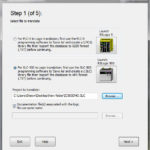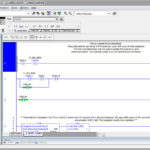
UPDATE: Rockwell has release a new version of this tool with additional features. To get the latest version, search the below website for “RSLogix Project Migrator (it also comes with RSLogix/Studio 5000 v19 and up)”
 Having used Rockwell’s Translate PLC-5 SLC utility on multiple occasions, and having discussed it’s practical use with other programmers time and again, I recently sent the following recommendations to Rockwell:
Having used Rockwell’s Translate PLC-5 SLC utility on multiple occasions, and having discussed it’s practical use with other programmers time and again, I recently sent the following recommendations to Rockwell:
INTs vs. DINTs
One of easier things I would like to see changed in the “Translate PLC-5 SLC 2.0 utility” is the automatic conversion of PLC-5 and SLC-500 INTs (integer data) to DINT’s (double integers.)
On first past, it would seem like a good idea to convert INT’s to DINTs. But in certain applications the converted program won’t work if the former INT data files are converted to DINT’s. So my recommendation is to give the user the option whether INT’s should be converted to DINT’s when they run the utility.
SCP Conversion
 While it’s helpful to have SCP instructions converted, the resulting code gives most users a migraine.
While it’s helpful to have SCP instructions converted, the resulting code gives most users a migraine.
The SLC-500 SCP instruction not only scales values, but also acts as a good visual aide displaying what the raw value is being scaled to. The converted code, while functionally accurate, is nowhere near as easy to decipher.
In fact, it’s quite odd that after 14 years there’s still no native SCP instruction for ladder logic in RSLogix 5000. That aside, since there has been an SCP add-on instruction available since the dawn of AOI’s, why not allow the option to convert SLC-500 SCP’s to the Rockwell sample code version of the SCP AOI?
Long symbol names
The ability to import text and symbols from the PLC-5 and SLC-500 is valuable, but why is the utility limited with reguards to Symbol length? From a coding standpoint, it doesn’t make sense to “truncate” long Symbol names since the Logix platform supports tag names much longer than any Symbol supported in APS, Ai, or RSLogix 500.
 In large projects, when you truncate these names you end up with multiple tags with the same name. This is because most tag’s unique characters are often at the end of the tag name as opposed to the beginning (i.e. Plant1_Building1_Line1_Tank1 and Plant1_Building1_Line1_Tank2 both currently get truncated to the same name.)
In large projects, when you truncate these names you end up with multiple tags with the same name. This is because most tag’s unique characters are often at the end of the tag name as opposed to the beginning (i.e. Plant1_Building1_Line1_Tank1 and Plant1_Building1_Line1_Tank2 both currently get truncated to the same name.)
Well those are my three recommendations for updating the Translate PLC-5 SLC 2.0 utility. If you’ve used it and have your own thoughts on how it could be made better, please share them with us here by leaving your comment in the “post a comment or question” link below.
Until next time, Peace ✌️
If you enjoyed this content, please give it a Like, and consider Sharing a link to it as that is the best way for us to grow our audience, which in turn allows us to produce more content 🙂
Shawn M Tierney
Technology Enthusiast & Content Creator
Support our work and gain access to hundreds members only articles and videos by becoming a member at The Automation Blog or on YouTube. You’ll also find all of my affordable PLC, HMI, and SCADA courses at TheAutomationSchool.com.
- FactoryTalk Design Workbench First Look, CCW Comparison - December 19, 2025
- Drew Allen of Grace Technologies on Automation, Safety, and More (P256) - December 17, 2025
- Robotics in Warehouse Automation with Erik Nieves of Plus One Robotics (P255) - December 10, 2025

Discover more from The Automation Blog
Subscribe to get the latest posts sent to your email.




Actually, when you consider all that could go wrong with a translation tool like this, you just have to be happy that it does as good a job as it does. The INT/DINT thing is something you just need to consider…probably not a good default fix to this…as many pro-DINT arguments as there are pro-INT.
Good afternoon Jeff,
Very good point – thanks for sharing it.
Rockwell very recently released an update, but I haven’t had a chance to check it out yet – soon I hope!
Thanks again,
Shawn Tierney,
[sc name="stsigcom"]